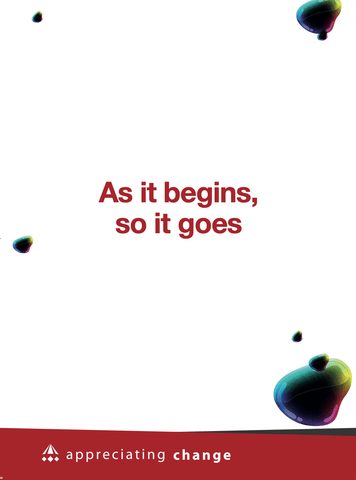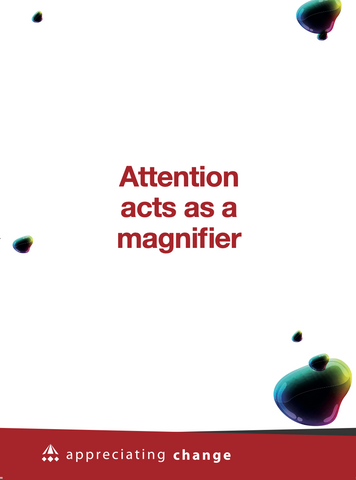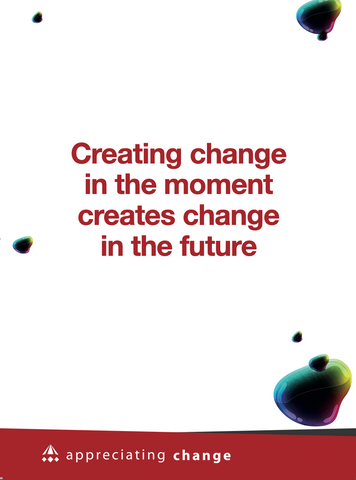Creative Workshop Exercises: Easy and Engaging Activities #6 Creative Conversations about Change
Impact: Move Change Forward through Creative Thinking
Materials needed: Appreciative Inquiry Card Pack, one per six participants. Stickies, Flipchart paper and pens.
Remember, if you decide to buy a pack you get 10% discount with a newsletter subscription
Professional Use: Consultants, Organisational Development Professionals, Change Agents, Leaders and Managers
It can also easily be adapted for individual work by therapists and counsellors, coaches
You can download this blog here
Who is this exercise for?
This exercise is designed to help groups that need to initiate some change, or where change has become stuck, to have creative conversations that open up possibilities. This might be when they are subject to planned change as well as when they are self-initiating change.
How does it help with achieving change?
Based on appreciative inquiry, the exercise works to stimulate thinking about different ways of conceptualising or engaging with the change. The cards present provocative statements about change, which can be used to stimulate conversation that open up new directions, possibilities, creative thinking and ideas for change.
How to conduct Creative Conversations about Change
Preparation
- Take the card packs and separate each one out into one pile of the 28 picture/quote cards and one for the other cards. Keep each pile separate. Turn the piles quote side up. Let’s imagine you have 12 people in the exercise here so you are using 2 packs of cards and so now have two piles of picture/quote cards
- Divide the your participants into subgroups of about 6 people around tables
- Give each table a pile of the quote cards
- Ask each table to look through the cards and pick the one that they find most interesting in the light of the current change challenge; an idea presented in the quote that they would be interested to explore and discuss
- Take feedback from all the tables, including what informed their choice, write each unique card suggested down in a list.
- Depending on the time available you can
- Work through the list, starting with any selected by more than one table
- Write the selected quotes up and give everyone two votes. They just need to make their two marks against the selected quotes. Add these up by quote. Start with the top-voted and keep going until time runs out
- Or if you only have time for one round of discussion, you can designate ‘quote tables’. Place the relevant card on the table and ask people to assemble at the table of the quote they wish to discuss.
- For the purposes of these instructions I am going to illustrate two rounds, using the first model suggested above.
- We’re going to conduct the rest of the exercise using the world café model. If you want to learn more about world cafe please see here
- Mix the groups up then ensure each group separates (out of the cards in front of them on the table) the card that was top of the list you assembled in point 4 above. I’m going to imagine its: 'Attention acts as a magnifier'.
- Ask the group to discuss what this says to them, what it makes them think about, what it brings to mind and how it could be useful to thinking about change. You might offer them questions to discuss such as
- When you read this, what do you immediately think of in terms of words, experiences or images?
- Where is our attention going at the moment? Why is that attracting attention? How useful is the focus on this proving to us? Is it moving the change forward?
- What are we not focussing on, while we’re focused on this?
- How might directing our attention elsewhere be beneficial to us?
- What areas of possibilities do we want to magnify in our world?
- Give each group about 30-40 minutes to discuss these questions
- Take some brief, top-line feedback from each group on what they were struck by in their conversations
- Ask five people from each group to switch tables (or less people if there are only 2-3 tables) to remix the groups
- Then move on to the next card. I’m going to use 'Creating change in the moment creates change in the future' as an example
- As before, give each group 30-40 minutes to discuss what this means to them in the current context. To help the discussion, you might ask them to discuss questions like
- How does this idea make you feel?
- What does it mean, what possibilities does it offer, for you?
- What changes could we make now in our relationship to the change, our relationships in the organization, the way we work together that could possibly positively affect the future?
- What is your greatest wish for the future, and what could we be doing differently now that might make that more likely to come to pass?
- As before, take some brief, top-line feedback from each group on what they were struck by in their conversations
- Continue in this pattern leaving some time at the end for the next steps
Pulling it together
- Ask everyone, on three separate post-its, to write
- What out of today’s conversations most inspires them or most fills them with hope
- One change they believe they individually, or the group as a whole, can make quickly and easily that will move things forward
- One idea that is developing for them of ways the group could have an active, positive, influence on the change

- Arrange three flip charts headed, ‘What gives hope?’ ‘Today Tomorrow’, and ‘Something to aim for’
- Ask people to put up their stickies in the appropriate place
- Have a look as a group at the items under ‘What gives hope?’ Ask people what seeing all these stickies does for them – looking at them what do they see? Then ask for volunteers to share what has changed for them during the course of the conversation in terms of hope.
- Have a look as a group at the items under ‘Today Tomorrow?’ Ask people (everyone if possible) share what they personally are going to do following today to build on the discussions and ideas move things forward
- Cluster around the third flipchart. Ask the group what catches their eye, ask whoever wrote that one to expand on it. In this way stimulate general discussion. Then ask who would like to take the lead on making what happen, and who would like to help them?
- Make a note of these emerging ‘project teams’
By the end of this exercise you should have more hope in the room, some personal commitments to helping move things forward and some ambition to make things happen clustered around some key ideas.
The Cards used here are the Appreciative Inquiry Cards
Remember, if you decide to buy a pack you get 10% discount with a newsletter subscription






